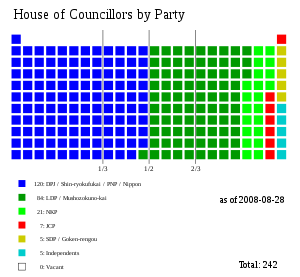House of Councillors
| Japanese House of Councillors 参議院 Sangiin |
|
| Type | |
|---|---|
| Type | Upper house |
| Leadership | |
| President | Satsuki Eda, DPJ since 2007 |
| Structure | |
| Members | 242 |
| Election | |
| Meeting place | |
 |
|
| National Diet Building, Tokyo | |
| Web site | |
| www.sangiin.go.jp/eng/index.htm | |
| Japan |
 This article is part of the series: |
|
|
|
|
Other countries · Atlas |
The House of Councillors (参議院 Sangiin?) is the upper house of the Diet of Japan. The House of Representatives is the lower house. The House of Councillors is the successor to the pre-war House of Peers, the Japanese equivalent of the British House of Lords. If the two houses disagree on matters of the budget, treaties, or designation of the prime minister, the House of Representatives can insist on its decision. In all other decisions, the House of Representatives can override a vote of the House of Councillors only by a two-thirds majority of members present. However with the introduction of proportional representation in the House of Representatives, the upper house has significantly enhanced its power to block legislation with final effect at the expense of the former where the government fails to attain the two-thirds mark in almost every general election, such as in the recent case of the Postal Privatisation Bill block; this development has made the House of Councillors quite powerful, perhaps approaching the Australian Senate or the United States Senate in its ability to influence public policy.
The House of Councillors has 242 members who each serve six-year terms, two years longer than those of the House of Representatives. Councillors must be at least 30 years old, compared with 25 years old in the House of Representatives. The House cannot be dissolved, as only half of its membership is re-elected at each election, using a parallel voting system. Of the 121 members subject to election each time, 73 are elected from the 47 prefectural districts (by single non-transferable vote) and 48 are elected from a nationwide list by proportional representation. Up to the 1998 election, there were 252 members, 126 elected at a time: 76 from prefectural districts and 50 elected nationwide. At the 2001 elections these numbers were reduced and the total number was 247 (126 elected in 1998 and 121 elected in 2001).
See List of members of the Diet of Japan for the list of current members of the House of Councillors.
Latest election
| Parties | Proportional votes | % | Prefectural seats 2007 | Proportional seats 2007 | Not up | +/– | Elected in 2007 | Total seats |
|---|---|---|---|---|---|---|---|---|
| Democratic Party of Japan (DPJ) Minshutō | 23,256,242 | 39.5 | 40 | 20 | 49 | +11 | 60 | 109 |
| Liberal Democratic Party (LDP) Jiyū Minshutō | 16,544,696 | 28.1 | 23 | 14 | 46 | –9 | 37 | 83 |
| New Komeito Party (NKP) Shin Kōmeitō | 7,762,324 | 13.2 | 2 | 7 | 11 | –2 | 9 | 20 |
| Japanese Communist Party (JCP) Nihon Kyōsantō | 4,407,937 | 7.5 | 0 | 3 | 4 | –1 | 3 | 7 |
| Social Democratic Party (SDP) Shakai Minshutō | 2,637,716 | 4.5 | 0 | 2 | 3 | –1 | 2 | 5 |
| People's New Party (PNP) Kokumin Shintō | 1,269,220 | 2.2 | 1 | 1 | 2 | 0 | 2 | 4 |
| New Party Nippon (NPN) Shintō Nippon | 1,770,697 | 3.0 | 0 | 1 | 0 | +1 | 1 | 1 |
| Others | 1,264,841 | 2.1 | 7 | 0 | 6 | +6 | 7 | 13 |
| Total | 121 | 121 | 242 | |||||
| Source: [1] | ||||||||
